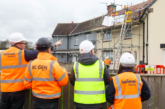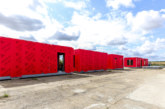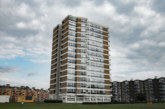Simon West, COO and co-founder of Glasgow-based proptech arbnco, discusses the importance of properly ventilating the UK’s classrooms following the company’s involvement in a £1.75m Government pilot to tackle Covid-19 transmission in schools.
The pandemic initiated a conversation about air quality on a global scale, with the evidence quickly suggesting that airborne transmission of infectious particles is a principal way in which the virus spreads — both at a conversational distance and in poorly ventilated settings.
There’s been no shortage of scientific papers published about Covid-19 and air quality over the past two years. Research from Imperial College London in June 2021, for example, unearthed a correlation between the severity with which a person experiences the effects of Covid-19 and long-term exposure to air pollution.
The importance of improving air quality pre-dates and extends beyond the more immediate concerns of the pandemic, though. The long-term health impacts of poor air quality are not insignificant: asthma cases, for instance, have been consistently and directly linked to pollution, with American scientists estimating that one in 12 new child asthma cases worldwide are attributable to exposure to nitrogen dioxide (NO2) — a toxic gas produced by diesel vehicles.
These findings, combined with the increased susceptibility of children to air pollution-related health issues such as impaired lung function, make poor air quality an issue of particular concern to parents and educators.

From polluted playgrounds to clean-air classrooms
It’s little comfort to note then that indoor air can often be more polluted than that outside — as shown by a joint report from the Royal College of Paediatrics and Child Health and the Royal College of Physicians.
Opening windows has come highly recommended as a solution to deal with Covid-19 transmission, but doing so limits the ability to control air humidity and temperature and also risks exposing children to vehicular pollution, which a recent study showed to be at a “dangerously high” level in the surroundings of over 25% of all British schools and colleges.
With children spending on average just over an hour outdoors a day, the healthiness of the indoor environment in which they learn and play is critical.
Tackling the problem
One interesting idea floated by the Building Engineering Services Association (BESA) in 2020 was to make air quality part of the OFSTED inspection regime. More recently, the Government launched an initiative to trial air cleaners in UK schools in the hope to combat student absences related to Covid-19 and other airborne viruses.
arbnco has been a chief partner of the £1.75m pilot scheme, which commenced in September 2021, working alongside the universities of Leeds, Bradford and York, Bradford Council, the Department of Health & Social Care and the Department for Education.
30 schools are participating in the live trial: 10 have received high-efficiency particulate air (HEPA) filters that trap particles such as dust, pollen and bacteria from the air; a further eight had UV-C technology installed — devices that cycle air through an enclosed unit and expose it to a UV germicidal light and inactivating microorganisms; and the remaining 12, which have no devices, act as a control group.
To analyse how pure the air is following filtration (or not), all classrooms have been fitted with arbnwell — this is arbnco’s platform offering centralised control and continuous high-resolution sensing of air quality and environmental conditions, such as CO2, volatile organic compounds (VOC), particulate matter, temperature and humidity. By gathering quantitative and qualitative data, arbnwell allows for a full assessment of the human experience and the effectiveness of the air cleaners to reduce the risk of transmission in these educational settings.

A pilot full of possibility
The potential of the trial is enormous. If successful, it could make a tangible difference to managing Covid-19 and helping to minimise disruption to education by reducing absences. By also gathering data that provides insight on the overall air quality in these school settings, we’ll hopefully be able to improve the health and wellbeing of young students — particularly those with asthma and hay fever — and ensure that children are spending the bulk of their day in an environment that is safe, healthy and comfortable.
The project runs for the full academic year, and depending on how the results shape up, there’s a big and exciting opportunity to roll out the technology nationwide throughout 2022. Moving forward, as important as it is to identify any initial problems with ventilation, so too is the continuous monitoring of these air quality status indicators via sensory technology. This will be key to achieving consistent improvements to environmental quality.
Change is in the air
The past two years have been a high-profile education on the importance of proper ventilation; the hope is that this trial with Bradford schools will teach us valuable lessons as to how this applies to schools, helping us to better protect children in their classrooms.
It’s not too much to say that getting the air quality and ventilation right in our schools could be the key to improving the health and wellbeing of the nation as a whole.









